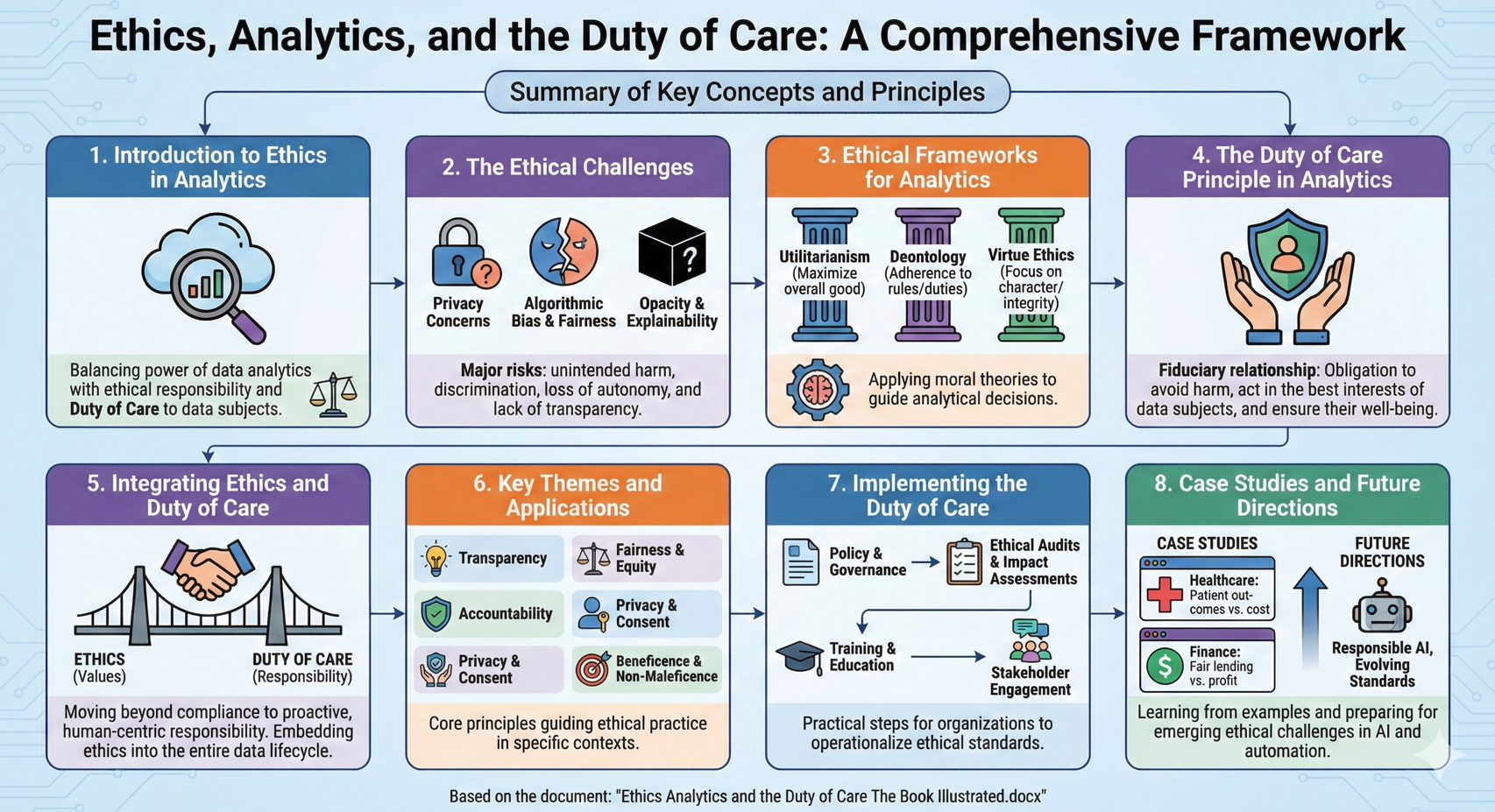The Nano Banana Image
So, I was trying to make an infographic of my 1,000 page manuscript on ethics and AI, and I entered this into Google Gemini. It wasn't the Nano Banana tool I was using, so instead I got this summary:
| Nano Section | Description & Key Concepts (Sources) | Visual Element & Notes |
| B: Broad Context | The course begins by establishing the wide context of challenges facing society: complexity, chaos, rapid change, globalization, division, and management of complex events (Snippet 1). The central question is set: "What is it like to thrive, and shall we say, live ethically in a mesh?" (Snippet 2), moving away from hierarchical ("tree") structures. | Image of Mesh vs. Hierarchy/Tree: A graphic illustrating a traditional hub-and-spoke (tree) network versus a distributed, decentralized (mesh) network (Snippet 2). |
| A: Analytics Scope (The AI) | Defining Analytics: Analytics and AI are used interchangeably, broadly covering machine learning and deep learning via neural networks, focusing less on symbolic rules (Snippet 3). | Image of Neural Network Layers: A simplified diagram showing input, hidden, and output layers in a neural network (Snippet 2, 3). |
| N: Necessary Applications | AI/Analytics applications are widespread, extending beyond simple recommendations: Descriptive, Diagnostic, Predictive, Prescriptive, Generative, and Deontic Analytics (Snippets 6, 7, 9, 10, 11). Examples include Academic Advising, Spam Detection, and even "Deontic Analytics" (determining "what should be"). | Visualizing Analytics Types: A multi-panel graphic showing examples of a dashboard (Descriptive) and a prediction funnel (Predictive) (Snippets 6, 9). |
| A: Acknowledge Issues | Ethical issues arise both when AI works (surveillance, microtargeting, lack of appeal/discretion, manipulation, discrimination) and when it doesn't work (error, bias, unreliability) (Snippets 13, 14, 15). The Scale of data, Access to information, and the rise of new Recordkeepers amplify ethical questions (Snippet 3). | Image of Ethical Crossroads/Scale: A graphic representing a weighing scale, symbolizing justice and ethical trade-offs (Snippet 12). |
| N: Navigate Theory | Traditional ethical theories (Virtue, Duty, Consequentialism, Social Contract) offer frameworks, but each has limitations (Snippet 3, 25). The focus shifts to Meta-Ethics (the study of ethical reasoning) and the Duty of Care, which is relational, contextual, and focuses on vulnerability and relationships (Snippet 24, 25). | Infographic Flowchart of Ethical Theories: Small icons/text for each theory with associated weaknesses (e.g., Trolley for Consequentialism, Rules for Duty) (Snippet 24). |
| A: Act in Practice (The Workflow) | The AI/Analytics Workflow (Data $\rightarrow$ Model $\rightarrow$ Deployment) involves numerous decisions with ethical impact (Snippet 27). Key practice areas include Data Governance (avoiding bias, managing consent), Model Development (tweaking biases, interpreting non-semantic results), Testing, and Evaluation (Snippets 27, 29, 31, 32, 34, 35). | Workflow Diagram: A flowchart showing the steps of the AI/Analytics workflow (Data, Model, Application, Testing, Evaluation) with decision points labeled (Snippet 27). |
| N: New Ethics (Down the Staircase) | Ethical progress moves down the staircase from formal Regulation (least flexible) to Practices, Governance, Culture, and ultimately Individual Agency (most flexible, based on joy rather than fear) (Snippet 46). AI ethics is dependent on Societal Ethics (Snippet 46). | Staircase Graphic: A visual representation of the staircase with labels (Law/Regulation at the top, Agency/Joy at the bottom) (Snippet 46). |
| A: Agency and Harmony | Ethical AI = Ethical Society: Agency is expressed in different ways (power, competence, feeling, ownership). A person's ethics are derived from their moral sentiment and lived experiences, not universal rules (Snippet 44, 46). The goal is an Ethics of Harmony (Sensation/Feeling) where the individual acts as an Ethical Citizen (Snippet 46, 47). | Final Image of Harmony/Interconnectedness: An abstract image showing smooth, interconnected elements or a simple dewdrop (Snippet 46). |
This summary is pretty good. It's not an exact representation of what I wrote (the BANANA acronym contorts it a bit) but it's pretty accurate.
Here's the infographic Nano Banana actually produced, which by contrast completely misrepresents the manuscript.
So what did the graphic get wrong?
1. At no point do I say the topic is anything remotely like "balancing" analytics with responsibility and a duty of care. In fact, I argue against the idea of ethics being a 'balance'. I view it as an opportunity - a map or a guide, if you will - to do good.
2. While I do list a large number of ethical issues in analytics, as documented in the literature, I don't represent them as 'challenges' or 'risks'.
3. The infographic lists three ethical frameworks. In my article, I list four, adding 'contractarian' ethics. Also, I call the first set of ethics 'consequentialist' ethics (of which utilitarianism is only one type). I also discuss metaethics, which is not mentioned at all.
4. I do not describe 'the duty of care' as 'fiduciary responsibility'. I mention this legal description briefly, and then explicitly say this is not what I am talking about. I reference the duty care as described by authors such as Gilligan, Tranto and hooks.
5. I don't talk about 'integrating ethics and the duty of care'. If anything, care ethics form a fifth branch of ethics. Also, I don't talk in terms of ethics as 'values' and care as 'responsibility'.
6. The six key themes and applications are among the sixteen values depicted in the various codes of ethics I analyzed. I don't talk of these as 'guiding' ethical practice. I do discuss the codes at some length, though this is not mentioned here. I argue that there is no set of values all such codes have in common.
7. The 'implementing the duty of care' slide is entirely made up and does not correspond to any part of what I wrote.
8. The case studies section is also made up. I do not discuss these case studies at all.


Comments
Post a Comment
Your comments will be moderated. Sorry, but it's not a nice world out there.